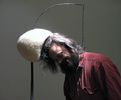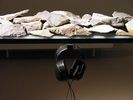Do-it-yourself music
'Listening enraptured to the throbbing dance of the cobblestones and their seams'
(Frauke Eckhardt)
It was Joseph Beuys (1921-1986) who left behind the well-known dictum 'Everyone is an artist'. He also coined the phrase 'Everyone is a musician' in the early 1980s during a round-table discussion on Austrian Television involving, among others, the composer György Ligeti (1923-2006). This latter fact has passed fully unnoticed. Most people consider music something they love, need and admire, but they fail to explore their own creative potential in music. Instead of toying and experimenting with the acoustical potential themselves, they tend, with alarming and ever-increasing frequency, to leave music-making to the virtuosos and experts. It is precisely this social deficiency, which also marks an artistic defect in our society, that forms the starting point for Frauke Eckhardt's art.
Frauke Eckhardt was born in Frankfurt am Main in 1968. Like Beuys, she is a trained sculptor. After taking a degree in stone sculpture she studied art, public space and dance sculpture at the Nuremberg School of Fine Arts (1993-7) and later audio-visual art at the Saar School of Fine Arts in Saarbrücken (until 1999). Since then she has lived and worked in Saarbrücken.
Eckhardt builds on Beuys's legacy by firmly implanting the ear as a crucial organ of perception in her installations and mobile space-sound exploration sculpture. Hardly any other sound-artist of her generation can match that hidden aspect of her sculpture that Beuys once called 'the quest for the true shape of things'. Eckhardt treats this quest as a game and a process in her works, kindling a joy of discovery and an urge to explore, inspiring onlookers to 'see' the world afresh with their ears.
Eckhardt's objects and installations contain music for people passing by ? ?do-it-yourself music?. Her audio vehicles Klangmobil ('Soundmobile', 1999) and Klangroller ('Sound roller', 2000), the mobile RaumKlangRezeptoren ('Space-sound receptors', 2001) and her interactive cactus environment Klanglandschaft ('Sound landscape', 2002) invite us to become composers ourselves. The moment we use these technically sophisticated yet easy-to-operate vehicles and devices we automatically tap our musical potential. For every well-trodden path and practised activity has a ?sound track? that Eckhardt's mobile objects make subtly audible through miking and sometimes through recording. Participants gain unusual aural experiences by exploring the grounds and making genuine self-discoveries influenced individually by their choice of path, choice of action, and speed. What we otherwise never perceive, at least not at this level of immediacy, are the sounds we create with our own forward motion, always on the basis of the elements we touch and their material consistency. This combination of mobility and staticity is fully comparable to traditional composing, which works with pre-set pitch arrays, instrumental ensembles and other existing parameters to create a score as the prerequisite for the envisioned piece of music. But Eckhardt does not write down a musical text. All she constructs are the premises, the reading and listening devices that enable visitors to experience the real world as an ever-mutable musical score. At the same time she lets us function as composer and performer alike, and hence as musicians in Beuys's sense, learning to take advantage of our own artistic creativity. That is precisely what visitors must do when they temporarily occupy Eckhardt's seating furniture Klangsurfer ('Sound surfer', 2009) in the exhibition 'Klangkunst ? A German Sound': they have to become active, to listen and marvel ? and listen again.
Stefan Fricke
produced by
Deutscher Musikrat gemeinnützige Projekt-
gesellschaft mbH
Förderprojekte
Zeitgenössische Musik
Weberstraße 59, 53113 Bonn
P 02 28 - 20 91 170
F 02 28 - 20 91 200
E zm@musikrat.de
curators of the exhibition
Stefan Fricke,
Johannes S. Sistermanns



